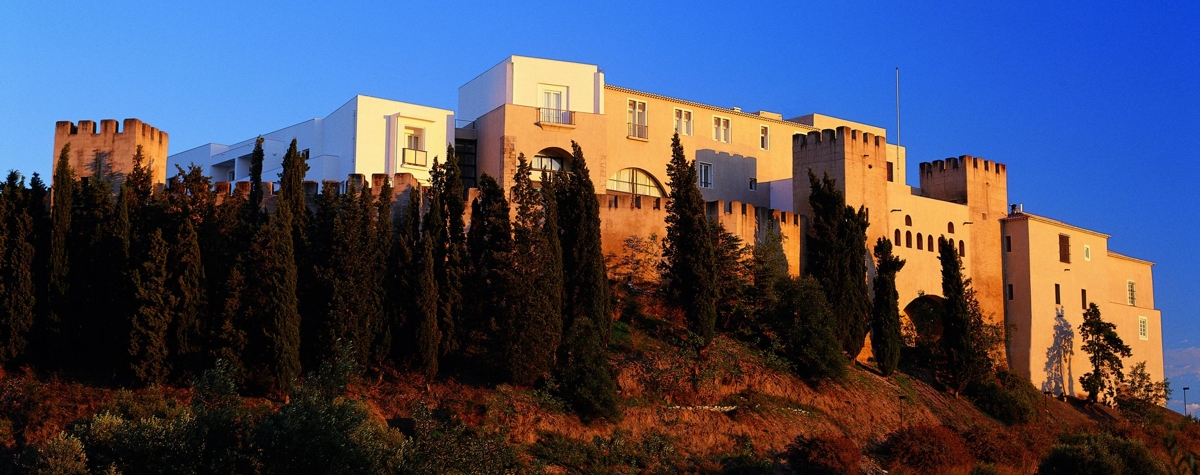The Castle of Alcácer do Sal (Portuguese: Castelo de Alcácer do Sal) is a medieval castle located in the civil parish of Alcácer do Sal (Santa Maria do Castelo e Santiago) e Santa Susana, in the municipality of Alcácer do Sal, Portuguese district of Setúbal.
It predominates over the Sado valley, the hilltop on which it was implanted was successively occupied since the 6th century, becoming an important urban and military centre on the Moorish peninsula. The castle was likely constructed in the 12th century, that succeeded various older fortifications. The castle had 20 towers of more than 25 metres (82 ft) and a large keep tower, two gates along the north (including the Porta Nova in the north and the Porto de Ferro in the east).
Archeological excavations occurring in the 20th century, proved that Alcácer do Sal was constructed during the Almohad Caliphate, during a period of Moorish occupation in the Iberian peninsula.
It was conquered in 1158 by D. Afonso Henriques, but was retaken in 1191 by the Arab Moors, as evidenced by the construction of the pentagonal tower during its occupation.
It was definitively reconquered in 1217, by King D. Afonso II, who donated it to the Order of Santiago. This military religious order remained seated in Alcácer do Sal until its move to Mértola. Beginning in 1289, the castle and fortifications were rebuilt.
In 1570, Rui de Salema and his wife, D. Catarina de Souto Maior, founded the Convent of Nossa Senhora de Aracaeli, to house/shelter the sisters of Poor Clares/Order of Saint Claire. The nuns were housed in the interior of the castle in the old residences of the former Commandery of the Order of Santiago and Royal Palace.
Following an earthquake in 1969, the site was damaged. The unstable accessways along the walls were reinforced in 1971, along with repaving the foundations, filling of cracks along the parapets and the masonry (to imitate the taipa removed from the site). This was extended in 1975 to include work along the western wall of the clocktower. Between 1982 and 1983, the restoration of the adarves and battlements were undertaken, and continue the restoration of the walls and turrets. This turret was immediately reconstructed in 1985 in stone masonry, with imitation taipa. In successive years (1986, 1987 and 1988) there were recovery works: reconstruction, improvement and consolidation of the walls and turrets.
It was conquered in 1158 by D. Afonso Henriques, but was retaken in 1191 by the Arab Moors, as evidenced by the construction of the pentagonal tower during its occupation.
It was definitively reconquered in 1217, by King D. Afonso II, who donated it to the Order of Santiago. This military religious order remained seated in Alcácer do Sal until its move to Mértola. Beginning in 1289, the castle and fortifications were rebuilt.
In 1570, Rui de Salema and his wife, D. Catarina de Souto Maior, founded the Convent of Nossa Senhora de Aracaeli, to house/shelter the sisters of Poor Clares/Order of Saint Claire. The nuns were housed in the interior of the castle in the old residences of the former Commandery of the Order of Santiago and Royal Palace.
Following an earthquake in 1969, the site was damaged. The unstable accessways along the walls were reinforced in 1971, along with repaving the foundations, filling of cracks along the parapets and the masonry (to imitate the taipa removed from the site). This was extended in 1975 to include work along the western wall of the clocktower. Between 1982 and 1983, the restoration of the adarves and battlements were undertaken, and continue the restoration of the walls and turrets. This turret was immediately reconstructed in 1985 in stone masonry, with imitation taipa. In successive years (1986, 1987 and 1988) there were recovery works: reconstruction, improvement and consolidation of the walls and turrets.
In the 1990s, work on re-covering the site and restoring the castle for use as a hostel began at this time, but was interrupted due to the discovery of an ancient Roman forum site.As a consequence, the property was taken over by the IPPAR Instituto Português do Património Arquitetónico (Portuguese Institute of Architectural Patrimony) by decree on 1 June 1992


